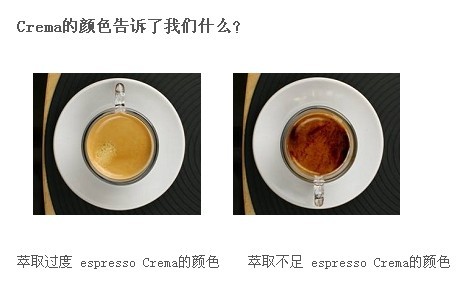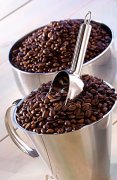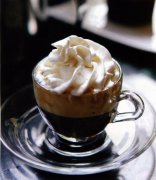The color of espresso crema tells us the knowledge of extraction.

The color of crema should be light reddish brown, but what does yellow-white or very black almost charred brown mean? The answer comes from drinks, because crema is actually carbon dioxide bubbles wrapped in brewed coffee, so the darker the foam means the stronger the coffee becomes a natural assumption. But it's actually very difficult to tell the color of coffee unless you dilute two cups of coffee or look at it under a microscope.
Another factor also plays an important role: the reflection of light from the foam means that the color of the coffee is much lighter than it actually is through the foam. And the smaller the foam, the greater the effect, so even if the espresso itself is very black, it may look very light (which explains why black beer has very white foam at the top).
A 15-second espresso usually has a whiter crema because it is lighter. Coffee powder is quenched by water for a relatively short time, and the viscosity of coffee is lower than that washed out in 25 seconds. For the same reason, coffee made from a lower water temperature will be lighter because it does not have enough energy to dissolve the substance in the coffee (it should be low solubility at low water temperature, not so-called energy). This also explains why excessive quenching can lead to the formation of crema that is as dark as charred.
Arabica coffee vs Roberta
There has long been a theory that Roberta can produce better crema during stamping. This is true because the aroma composition and aromatic oil content of Roberta is only half that of Arabica coffee. This means that less oil is quenched into coffee, thus reducing the effect of oil on foam stability, so increasing Roberta will reduce the overall amount of oil quenched from coffee powder, which means you have a higher chance of producing a more stable and richer Crema.
Food technologists will also tell you that reducing the amount of oil will make more body at the beginning of making coffee, and the lack of oil will cause the coffee to be different from that made from Arabica coffee. Therefore, it is generally adopted to add 5% of 10% Robosta, which will not significantly affect the quality of coffee, but can ensure the stability of crema. However, this theory can not explain the source of the additional crema. Other articles have explained that Roberta may contain different sugars, thus leading to this change.
I often collect some espresso with unique crema. A special case comes from "Yellow Bourbon" produced by a farm in Brazil. It tastes so sweet that if it is used to make espresso, even if it is baked nine days ago, it can still produce very rich and stable crema. Even when the liquid of the dry coffee is poured and the foam dries, it is still stable.
There are a variety of uncertainties that affect crema. In summary, it is how coffee preserves the foam of carbon dioxide, how many kinds and how many oils there are in coffee, and how they are quenched into the cup.

Tiger spots / markings
We often say that there must be red markings on the surface of the coffee. Spots are actually very fine ground coffee powders that are washed out in the early stages of the production process. I can often see them spread over the edge of the cup at first, and then spread over the whole surface with the process of punching. This implies that this cup is not only well made, but also well ground and is suitable for making espresso.
If the grinding is very consistent, it will have the opposite effect as expected, and it is difficult to combine the coffee powder closely. For example: one pool is full of volleyball, another pool, full of volleyball, football, tennis mixture, who will be denser. If each piece of coffee powder has a different shape and size and can be locked together, of course there is still some room for the water to flow normally.
In the cup, the tiger stripe means that the ground coffee powder is in the right range (which explains why the bean grinder is not set as fine as possible).
What Crema can tell us what can't tell us:
Crema can tell us:
1. Whether the coffee is fresh or not: a large number of Robosta beans allow us to see a lot of foam, so we can't judge the freshness of coffee by watching the speed at which the foam disappears. Fresh coffee will appear to be very crema throughout the production process (that is, when the coffee comes out, it looks like Coke spurting out), and only when a large amount of water appears, it will stop, thus dividing into two very obvious stages. Old coffee will often see a thin, separate foam in the process of ejection. The resulting coffee is often thin and watery, which means less crema and disappears faster.
2. The degree of coffee quenching: the deeper the Crema, the more dissolved matter enters the cup.
3. Uniformity of coffee quenching: the more stable the Crema, the better and stronger the coffee we make, which means that there are fewer gaps in the coffee powder and fewer mistakes in the production process.
What Crema can't tell us:
1. Whether the coffee is good or not: as long as it is fresh enough, no matter how bad the beans are, no matter how bad the roast can produce rich crema.
2. The oil in coffee is properly emulsified: for a long time, many people, including I thought, Crema told us the degree of quenching of oil in coffee, but the theory tells us that more oil, less foam. If you try making espresso with 5-6bar pressure, you will find that you can still make a lot of crema, but the coffee tastes very insipid because of lack of oil and aroma.
Crema, it's not complicated at all.
The production of Espresso and crema is often complicated, far more than is actually needed. Crema is a very simple part of the whole espresso production process.
Espresso has three main elements, one is water, the second is oily, and the third is foam. While the espresso body is gelatinous (the legendary soy sauce paste), the oil in the coffee is emulsified by hot water at high temperature and high pressure to form a colloid, which is extremely stable. The foam on the surface of espresso disappears very quickly compared to the colloid.
After eliminating the mysterious aura shrouded in Crema, Crema is still a great pleasure of espresso. Its honeycomb structure stores a lot of aromatic substances, releases a large amount of fragrance when the structure disintegrates, and brings enjoyment to our vision and smell at the same time.
Important Notice :
前街咖啡 FrontStreet Coffee has moved to new addredd:
FrontStreet Coffee Address: 315,Donghua East Road,GuangZhou
Tel:020 38364473
- Prev

Espresso espresso is the essence of coffee.
The charming fragrance of a cup of hot, smoking coffee just brewed from freshly roasted beans can pull sleeping people out of bed and lead passers-by into the cafe. Millions of people around the world would have trouble getting through the day without a bout of sanity caused by the caffeine in their coffee. Only in this seemingly ordinary drink, but
- Next

Fancy Coffee training knowledge Herbalife Coffee
Herbalife poured thick whipped cream on the Espresso, a more retro espresso, much like the aristocracy of tsarist Russia or the Austrian royal family, probably because whipped cream was relatively rare at that time. The fresh white cream floats gently on the deep coffee, just like a white lotus flower that comes out of the mud and is not dyed. Regular coffee
Related
- Beginners will see the "Coffee pull flower" guide!
- What is the difference between ice blog purified milk and ordinary milk coffee?
- Why is the Philippines the largest producer of crops in Liberia?
- For coffee extraction, should the fine powder be retained?
- How does extracted espresso fill pressed powder? How much strength does it take to press the powder?
- How to make jasmine cold extract coffee? Is the jasmine + latte good?
- Will this little toy really make the coffee taste better? How does Lily Drip affect coffee extraction?
- Will the action of slapping the filter cup also affect coffee extraction?
- What's the difference between powder-to-water ratio and powder-to-liquid ratio?
- What is the Ethiopian local species? What does it have to do with Heirloom native species?

